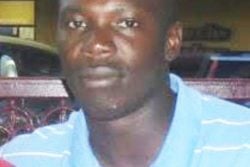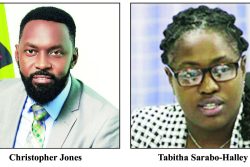On Sunday, September 22, 2024, at about 5.17 pm, Commander of Regional Police Division #1 Superintendent Krishna Ramana, ASP Kooldeep, Corporal Pachai, and Constable Fredrick were on mobile patrol along the Pakera road in Matthews Ridge, North West District, when they stopped a Black Toyota Fielder Wagon vehicle with registration number PAH 4429.
A release from the police said that the Commander requested a search of the vehicle for narcotics and the driver Cononiah Jupiter consented. During the search, the police said that they found two pouches containing leaves, seeds and stems, along with two joints suspected to be cannabis in Mr Jupiter’s pants pocket. The release said that Mr Jupiter was cautioned and admitted that the marijuana found was for his private use and that he used it as a medication. Mr Jupiter was arrested and taken to the Matthews Ridge Police Station. The suspected marijuana was weighed and amounted to 4.2 grammes. It is unclear what Mr Jupiter’s fate has been but he has been exposed to the public as a marijuana user and may face some fine or community service.
It may seem rather extreme that Mr Jupiter has been brought to book for a mere 4.2 grammes of marijuana in the same location where the purveyors of a massive cocaine escapade have apparently gotten away scot-free. The public doesn’t need reminding that on August 31st a joint operation involving the US Drug Enforcement Administration (DEA), the Customs Anti-Narcotic Unit (CANU) and the Guyana Defence Force (GDF) resulted in a 4,400 kilogrammes cocaine bust at Matthews Ridge, said to be the largest in the history of Guyana.
The cocaine valued at 176 million Euros was found in four separate pits just off an illegal airstrip and said to be camouflaged with tarpaulin and bush and packaged in what appeared to be cardboard boxes which were then sealed in transparent plastic bags. To date not a single person has been charged in connection with this operation. It is as if, to paraphrase Leona Helmsley, that drug charges are only for the small persons.
This was an elaborate operation quite clearly connected to a major drug outfit to the west of Guyana. It involved a breach of the country’s airspace, the landing of the drugs on an illegal airstrip and then a labour intensive operation to discharge the cargo. The plane took off and disappeared. A major operation then began on the ground to secrete the drugs in these bunkers. Perhaps the bunkers had already been excavated. Even that was a major operation that should have been detected by the various levels of law enforcement and local government.
Once positioned, the traffickers lay in wait. The best information was that these drugs were to be transported to the sea – some miles way – to be loaded onto a submarine-type vessel for onward shipment to Europe. This was the point at which the bust was made. It is left open to speculation that it was the better equipped DEA that picked up the intelligence that led to the compromising of the operation and local law enforcement was then roped into the operation.
Still, if the drugs in the bunker had not been discovered, a complex operation would have had to be launched to transport the drugs to the submersible. All things considered, this operation had probably been executed before. While it is significant that this shipment has been compromised and destroyed, leaving the kingpin short of 4,400 kilos of product there can be no comfort at this end.
Our western frontier cannot be subject to this type of wanton infiltration. Guyana has to be in control of every square inch of territory in that sector particularly given the various heightened threats to the country from Venezuela, a variety of gangs and unchecked movements across the border. The illegal airstrip, landing of the drugs and their bunkering represent a failure of the government and the Guyana Defence Force to protect our territory. This is one of the priorities that the administration should be concentrating on given the greater availability of resources.
What exactly CANU and the police force knew about this operation will not be revealed except that the top drug fighting unit in the country must be well-equipped and resourced to detect and uproot operations at an early stage. The swift change of the police command of the region following the bust tells its own story.
As Commander-in-Chief of the Armed Forces, President Ali has to be accountable to the public for the manner in which he and the Joint Services are protecting Guyana from the depredations of the drug industry. The August 31st bust did not provide a reassurance that those in authority knew what was happening at Matthews Ridge. A better performance is needed from the Joint Services.
The Matthews Ridge cocaine trail has now gone completely cold. There isn’t even any discussion of international collaboration to unearth the network which was involved. The public has grown accustomed to a lot of hype and talk after the fact but with little to no chance of arrests or prosecution. It is left to be seen whether this bust will have a denouement here.





